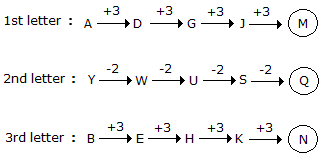Series Completion problems
- 1. b e d f? h j? l
Options- A. i m
- B. m i
- C. i n
- D. j m Discuss
Correct Answer: i m
Explanation:
b e d / f ? h / j ? l
Clearly in the first group, the second and third letters are respectively three and two steps ahead of the first letter.
A similar pattern would follow in the second and third groups.
- 2. A, G, L, P, S,?
Options- A. U
- B. W
- C. X
- D. Y Discuss
Correct Answer: U
Explanation:

- 3. ajs, gpy,?, sbk, yhq
Options- A. dmv
- B. mve
- C. oua
- D. qzi Discuss
Correct Answer: mve
Explanation:

- 4. AB, DEF, HIJK,?, STUVWX
Options- A. LMNO
- B. LMNOP
- C. MNOPQ
- D. QRSTU Discuss
Correct Answer: MNOPQ
Explanation:
The first letter of each term is two steps ahead of the last letter of the preceding term.
However, each term consists of consecutive letters in order.
- 5. Y, B, T, G, O,?
Options- A. N
- B. M
- C. L
- D. K Discuss
Correct Answer: L
Explanation:
I. Y,T, O and II. B, G, ?
I consists of 2nd, 7th and 12th letters from the end of the English alphabet, while
II consists of 2nd, 7th and 12th letters from the beginning of the English alphabet.
So, the missing letter in II is the 12th letter from the beginning of the English alphabet, which is L.
- 6. C, Z, F, X, I, V, L, T, O,?,?
Options- A. O, P
- B. P, Q
- C. R, R
- D. S, R Discuss
Correct Answer: R, R
Explanation:
I. C, F, I, L, O, ? and II. Z, X, V, T, ?

- 7. A, B, B, D, C, F, D; H, E,?,?
Options- A. E, F
- B. F, G
- C. F, I
- D. J, F
- E. J, K Discuss
Correct Answer: J, F
Explanation:
I. 1st, 3rd, 5th, 7th, 9th, 11th terms i.e. A, B, C, D, E, ? II. 2nd, 4th, 6th, 8th, 10th terms i.e. B, D, F, H, ?
Clearly, I consists of consecutive letters while II consists of alternate letters. So, the missing letter in I is F, while that in II is J. So, the missing terms i.e. 10th and 11th terms are J and F respectively.
- 8. Z, X, S, I, R, R,?,?
Options- A. G,I
- B. J, I
- C. J,K
- D. K,M Discuss
Correct Answer: G,I
Explanation:

Note that the numbers representing the difference between the consecutive terms of the series again from a series - 2, 5, 10, 17, 26, 37, 50 - in which the pattern is +3, +5, +7, +9, +11, +13.
- 9. AYBZC, DWEXF, GUHVI, JSKTL,?
Options- A. MQORN
- B. MQNRO
- C. NQMOR
- D. QMONR Discuss
Correct Answer: MQNRO
Explanation:

- 10. T, R, P, N, L,?,?
Options- A. J, G
- B. J, H
- C. K, H
- D. K, I Discuss
Correct Answer: J, H
Explanation:

More in Verbal Reasoning:
Programming
Copyright ©CuriousTab. All rights reserved.
